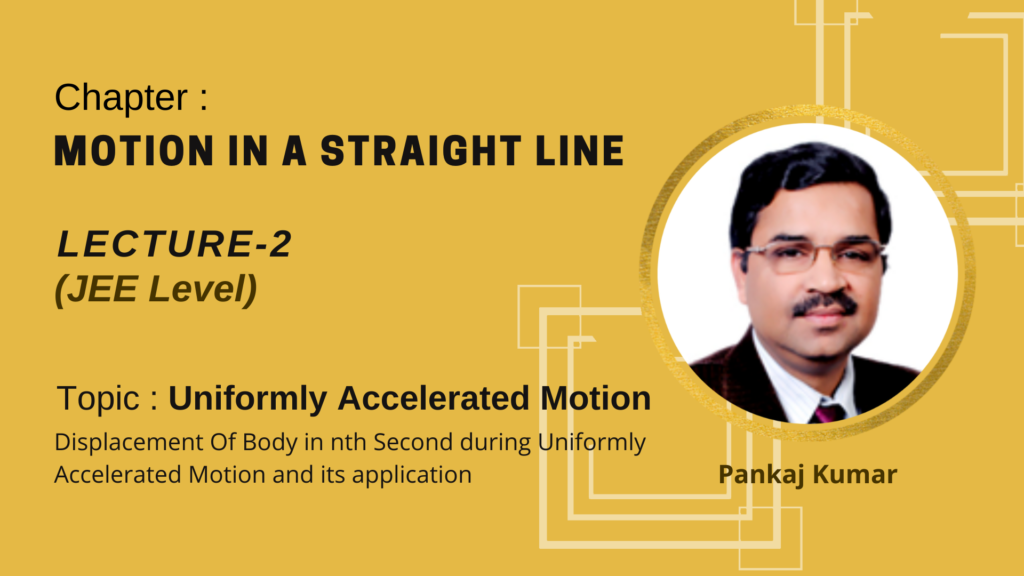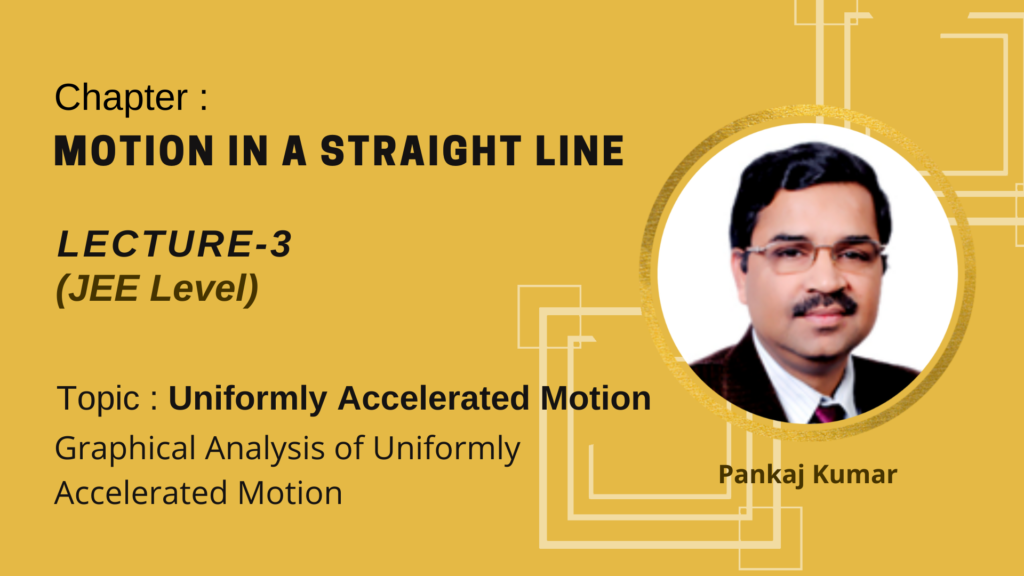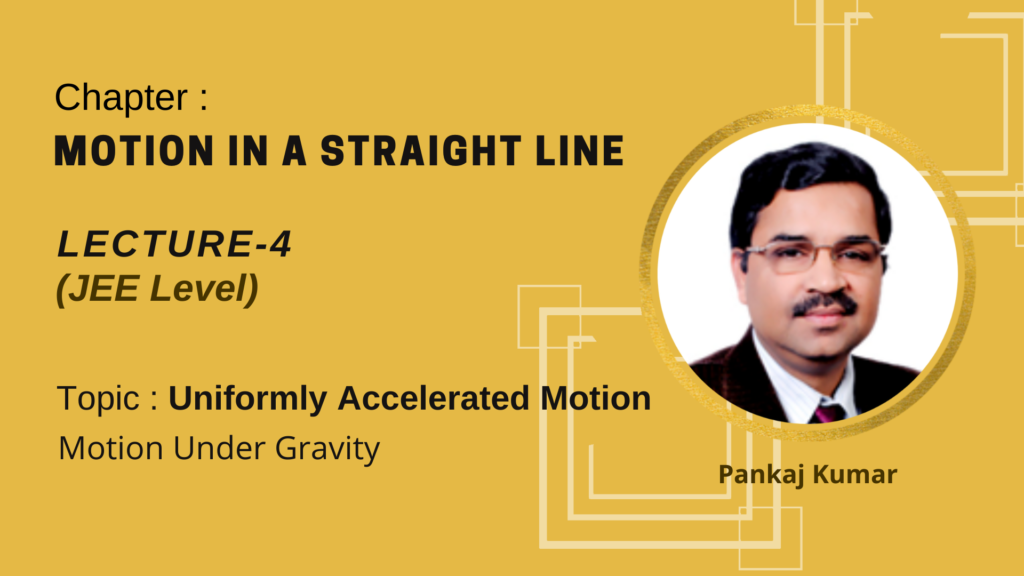Video Lectures
Theory For Making Notes
Introduction
When object is in Non-Uniform Motion or In a variable motion, the object will cover unequal distance in equal intervals of time.
The position-time graph of non uniform (varying) motion will not be a straight line.
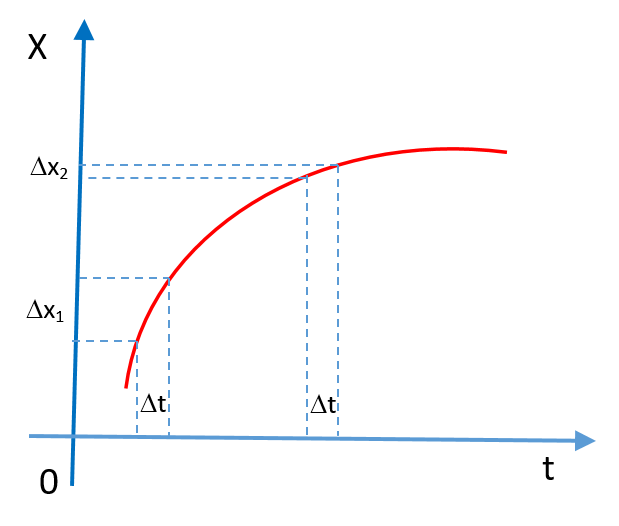
From the graph, it is clear that, object covers unequal distance in equal interval of time. Initially, in time Dt it covers a distance (Dx1) and after that it covers distance (Dx2) but in same time interval (Dt).
Average Acceleration and Instantaneous Acceleration
Very often, the velocity of a particle changes either in magnitude, in direction, or both as the motion proceeds. The body is then said to have an acceleration. The acceleration is defined as the time rate of change of velocity. The average acceleration is defined as
\vec{a}=\frac{{{{{\vec{v}}}_{2}}-{{{\vec{v}}}_{1}}}}{{{{t}_{1}}-{{t}_{1}}}}=\frac{{\Delta \vec{v}}}{{\Delta t}}
The direction of average acceleration (vector) is the direction of change in velocity (vector). Its unit is m/s2.
The instantaneous acceleration is defined by
\vec{a}=\underset{{\Delta t\to 0}}{\mathop {Lt}}\,\frac{{\Delta \vec{v}}}{{\Delta t}}=\frac{{d\vec{v}}}{{dt}}
In general, there is no relation between the direction of velocity vector and the direction of acceleration vector.
Graphical Analysis of Acceleration
Average Acceleration
The average acceleration between two points in a time interval is equal to the slope of the chord connecting the points on a velocity-versus-time graph.
Instantaneous Acceleration
The instantaneous acceleration at time t is the slope of the tangent drawn to the velocity-versus-time graph as shown below.The sign of the instantaneous acceleration depends on the slope of the tangent.In the diagram given below the slope is positive hence the acceleration is also positive.
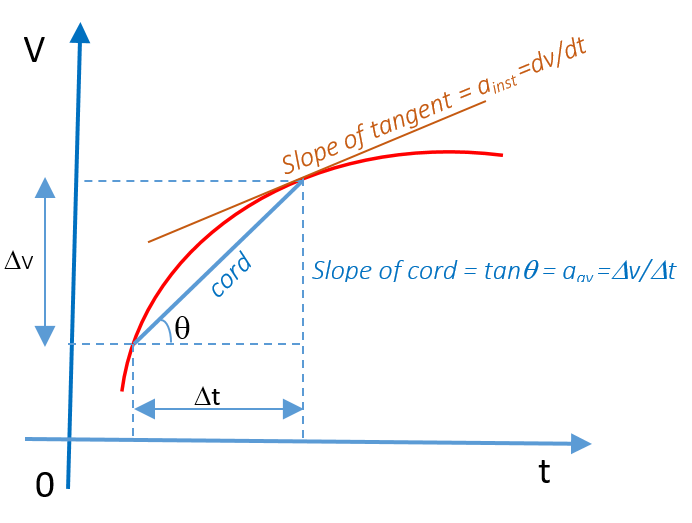
Non-Uniform Motion with Uniform Acceleration
In this section, we are going to derive relations among displacement, velocity, acceleration and time.
1st Equation of Motion
We know that, \frac{{dv}}{{dt}}\,=a
dv= adt
On integrating both sides,we get
\displaystyle \int\limits_{u}^{v}{{dv}}\,\,=\,\,a\int\limits_{0}^{t}{{dt}}
v = u + at … (1)
IInd Equation of Uniformly accelerated motion
Also we know that
\displaystyle \frac{{dx}}{{dt}}\,=\,v\,=\,u+\,at
or dx = (u + at)dt
On integrating, we get
\displaystyle \int\limits_{{{{x}_{0}}}}^{x}{{dx}}\,\,=\,\,u\int\limits_{0}^{t}{{dt\,+\,a\int\limits_{0}^{t}{{tdt}}}}
x = x0 + ut + \displaystyle \frac{1}{2}at2 … (2)
The equation (2) may be rewritten as
\displaystyle x={{x}_{0}}+t\left( {u+\frac{{at}}{2}} \right)
From equation (1), we have
x={{x}_{{0}}}+t(u+\frac{{v-u}}{2})
thus \displaystyle x={{x}_{0}}+\frac{1}{2}(u+v)t … (4)
IIIrd Equation of Uniformly accelerated motion
Eliminating t from equations (1) and (2), we get
v2 = \displaystyle u_{{}}^{2}\,+\,2a\,(x\,-\,{{x}_{0}}) … (3)
All these equations are called the equations of kinematics in one dimensional motion
The equations of kinematics are summarized as
v= u + at (1)
x = x0+ ut+ \displaystyle \frac{1}{2}\,a{{t}^{2}} (2)
\displaystyle {{v}^{2}}\,=\,u_{{}}^{2}\,+2a\,(x\,-\,{{x}_{0}}) (3)
x = x0 + \displaystyle \frac{1}{2} (u + v)t (4)
wherex0= initial position coordinate; x = Final position coordinate
v= final velocity; a = acceleration (constant)
t = time elapsed
Displacement of the particle in nth Second
Let an object is moving with initial velocity u under constant acceleration a.
To find the displacement in nth second, we subtract the position of particle at (n –1)th second from the position of the particle at nth second.
Displacement in nth second = \displaystyle {{s}_{n}}-{{s}_{{n-1}}}
\displaystyle s\left( {nth} \right)=un+\frac{1}{2}a\left( {{{n}^{2}}} \right)-\left[ {u\left( {n-1} \right)+\frac{1}{2}a{{{\left( {n-1} \right)}}^{2}}} \right]
\displaystyle =un\,+\,\frac{1}{2}a{{n}^{2}}-un+u-\frac{1}{2}a{{\left( {n-1} \right)}^{2}}
\displaystyle =u\,+\,\frac{a}{2}\,\left[ {{{n}^{2}}-{{{\left( {n-1} \right)}}^{2}}} \right] \displaystyle =u\,+\,\frac{a}{2}\,\left( {{{n}^{2}}-{{n}^{2}}-1+2n} \right)
Displacement in the nth second, \displaystyle s\left( {nth} \right)\,=\,u\,+\,\frac{a}{2}\left( {2n-1} \right)
Variation of Displacement (x), velocity (v) and acceleration (a) with respect to time for different types of motion.
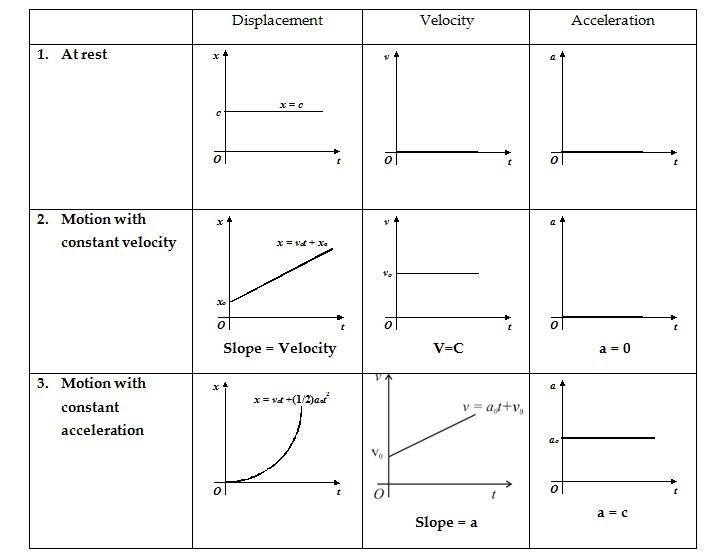

Points to remember :
1. The slope of displacement –time graph or position – time graph gives
velocity.
2. The slope of velocity – time graph gives acceleration.
3. The area under velocity-time graph gives displacement.
Illustration
The figure shows the x-t plot of a particle in 3-dimensional motion. Three different equal intervals of time are shown. In which interval the average speed is greatest and in which it is the least ? Give the sign of average speed for each interval.
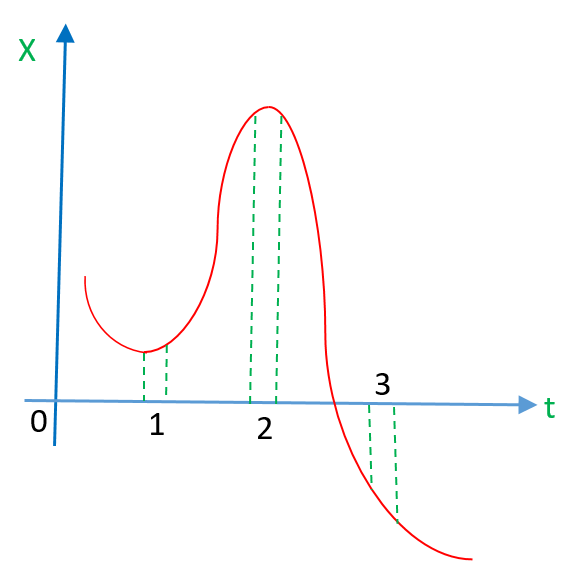
Solution :
We known that average speed in a small interval of time is equal to the slope of x-t graph in that interval of time.
The average speed is the greatest in the interval 3 because slope is greatest and the average speed is least in interval 2 because slope is least there (almost zero).
The average speed is positive in intervals 1 because slope of x-t is positive there and average speed is negative in interval 3 because the slope of x-t is negative.
Illustration
Figure shows x-t plot of one-dimensional motion of a particle. Is it correct to say from the graph that the particle moves in a straight line for t <0 and on a parabolic path for t >0 ? If not, suggest a suitable physical context for this graph
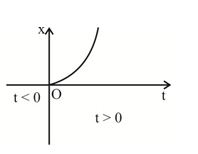
Solution
No, because the x-t graph does not represent the trajectory of the path followed by a particle. From the graph, it is noted that at t =0, x = 0.
The above graph can represent the motion of a body falling freely from a tower under gravity.
Illustration
Convert the given v – x graph shown in figure into a – x graph.
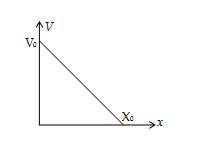
Solution
Equation of given curve is \displaystyle v=\left( {1-\frac{x}{{{{x}_{0}}}}} \right){{v}_{0}}
\displaystyle a=\frac{{dv}}{{dt}}=\frac{{-{{v}_{0}}}}{{{{x}_{0}}}}\frac{{dx}}{{dt}}=\frac{{-v_{0}^{2}}}{{{{x}_{0}}}}\left( {1-\frac{x}{{{{x}_{0}}}}} \right).
Hence graph between a and x is a straight line with negative intercept and positive slope.
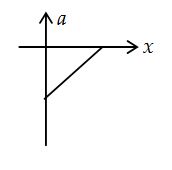
Free Fall (Motion under Gravity)
Motion that occurs solely under the influence of gravity is called free fall.
In the absence of air resistance all falling bodies have the same acceleration due to gravity, regardless of their sizes or shapes.
The value of the acceleration due to gravity depends on both latitude and altitude. It is approximately 9.8 m/s2 near the surface of the earth. For simplicity a value of 10 m/s2 is being used normally.
The equations of kinematics may be used with proper sign of each quantity
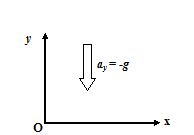
While using the equations of kinematics always remember that all quantities like v , a , S, u are vectors and hence their signs should be considered carefully. For our simplicity we take upward direction as +ve and downward direction as -ve.
Hence acceleration due to gravity is alway -ve because it is always downward irrespective of the motion of the body.
If a body is given an initial velocity upward it should be tken as positive and for downward initial velocity u should be taken as negative.
Hence we may write the equations as under
v = ±u –gt … (5)
y = y0+(±ut) – \displaystyle \frac{1}{2}gt2 … (6)
v2 = \displaystyle u_{{}}^{2}\,-2g\,(±S) … (8)
ALWAYS GIVE SIGN TO THE KNOWN QUANTITY. THE SIGN OF UNKNOWN QUANTITY WILL COME OUT AFTER CALCULATIONS.
Illustration
A stone ‘A’ is dropped from the top of a tower 20 m high. Simultaneously another stone ‘B’ is thrown up from the bottom of the tower so that it can reach just on the top of the tower. What is the distance of the stones from the ground while they pass each other?
Solution
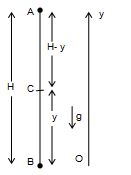
Let t be the time when they pass one another at point C at a height y from the ground.
Applying second equation of motion for both the stones i.e.
S= ut+ \displaystyle \frac{1}{2}g{{t}^{2}}
For stone B, y= ut + \displaystyle \frac{1}{2}(-g){{t}^{2}} … (i)
For stone A, -(H – y) = \displaystyle \frac{1}{2}(-g){{t}^{2}} … (ii)
From (i) and (ii),
H =ut … (iii)
Stone B can reach just the top of tower. Hence it final veloity is zero at the top. We can calculate the velocity of stone B from 3rd equation
\displaystyle v^{2}=u^{2}+2{{a}_{y}}S
Put v = 0, for S = 20 m and ay = -g
therefore from the 3rd equation we get u = 20 m/s
From (iii) t = \displaystyle \frac{{20m}}{{20m/s}}=1\sec .
From equation (i), the required distance (BC) from ground = 20 X 1 – 1/2 10 X 12 = 15 m
Illustration
A particle is thrown vertically upward. Its velocity at half of the height is 10 m/s, then maximum height attained by it is: (g = 10 m/s2)
(A)8 m
(B) 20 m
(C)10 m
(D) 16m
Solution
Suppose after travelling distance s, particle has the velocity 10 m/s.
So, v2 = u2– 2as
(10)2 = u2 – 2 x 10s …(1)
At the maximum height, i.e. 2s, v = 0
0 = u2-2g(2s)
u2 = 40s …(2)
From Eqs. (1) and (2), s = 5 m
hence total height i.e. 2s = 10 m
therefore option (c) is correct
Practice Questions (Basic Level)
1.
Ball A is dropped to the ground from the top of a tower while another ball B is thrown towards the earth with some initial velocity from same tower. Neglecting air resistance, the acceleration is
(a) same for both the balls
(b) greatest for the dropped ball A
(c) greatest for the ball B
(d)depends upon the sizes of A and B
Ans. (a)
2.
A body moving with a uniform acceleration from the state of rest covers a distance x = 450 m during time t = 6s. At what distance from the initial position is the body four seconds after the beginning of motion ?
(a) 300 m
(b) 200 m
(c) 400 m
(d) 150 m
Ans. (b)
3.
Two bodies of masses m1and m2 fall from heights h1 and h2 respectively. The ratio of their velocities when they hit the ground is
(a) \frac{{{{h}_{1}}}}{{{{h}_{2}}}}
(b) \sqrt{{\frac{{{{h}_{1}}}}{{{{h}_{2}}}}}}
(c) \frac{{{{m}_{1}}{{h}_{1}}}}{{{{m}_{2}}{{h}_{2}}}}
(d) \frac{{{{h}_{1}}^{2}}}{{{{h}_{2}}^{2}}}
Ans. (b)
4.
A parachutist after bailing out falls 50m without friction. When the parachute opens, it decelerates at 2 ms–2. He reaches the ground with a speed 3 ms–1. At what height did he bail out?
(a) 290 m
(b) 340 m
(c) 198 m
(d) 298 m
Ans. (d)
5.
You observe an object covering distances in direct proportion to the square of the time elapsed. The acceleration is
(a) zero
(b) constant
(c) decreasing
(d) increasing
Ans. (b)
6.
If a body having initial velocity zero is moving with a uniform acceleration of 8 m{{s}^{{-2}}}, then the distance traveled by it in fifth second will be
(a) zero
(b) 36 m
(c) 40 m
(d) 100 m
Ans. (b)
7.
A cricket ball and a tennis ball are simultaneously thrown upwards from the ground with equal initial speeds. Ignoring air resistance, which of the following statements is correct?
(a) Both the balls travel the same distance in the same time.
(b) Tennis ball rises the highest.
(c) Tennis ball is in flight the longest.
(d) Tennis ball has a smaller impact speed.
Ans. (a)
8.
A stone falls from a balloon that is descending at a uniform rate of 12 ms–1. Its velocity after 10 seconds from the point of release is
(a) 114ms–1
(b) 113ms–1
(c) 112 ms–1
(d) 115ms–1
Ans. (c)
9.
The displacement of a freely falling body is proportional to the
(a) time of fall
(b) square of the time of fall
(c) mass of the body
(d) square of mass of the body
Ans. (b)
10.
A man standing at the top of a building throws a ball vertically upward with a velocity of 10 ms–1. The ball reaches the ground 4 s later. What is the maximum height reached by the ball? How high is the building?
(a) 6 m above the building, 40 m
(b) 7 m above the building, 50 m
(c) 9 m above the building, 60 m
(d) 5 m above the building, 40 m’
Ans. (c)
11.
A car from rest start accelerating uniformly to a speed of 144km{{h}^{{-1}}} over a distance of 400 m. The time taken is
(a) 5 s
(b) 10 s
(c) 15 s
(d) 20 s
Ans. (d)
12.
A ball falls freely from rest. The ratio of the distances traveled in first, second, third and fourth second is
(a) 1 : 1 : 1 : 2
(b) 1 : 1 : 1 : 3
(c) 1 : 2 : 3 : 4
(d) 1 : 3 : 5 : 7
Ans. (d)
13.
Two bodies are thrown vertically upwards with their initial velocity in the ratio 2 : 3. Then the ratio of the maximum height attained by them is
(a) 1 : 1
(b) 4 : 9
(c) 2 : 3
(d) \sqrt{2}:\sqrt{3}
Ans. (b)
14.
A stone is dropped under gravity from rest from a height and it travels a distance \frac{{9h}}{{25}} in the last second. What is the height h? ( g = 9.8 ms-2 )
(a) 145 m
(b) 100 m
(c) 122.5 m
(d) 100 m
Ans. (c)
15.
A car starts from rest with an acceleration of 2 ms-2 for 5 sec and then move with constant velocity for next 5 sec.and finally retard at 2 ms-2 to come to rest. Find its average velocity.
(a) 5.8 m/s
(b) 6.67 m/s
(c) 8.76 m/s
(d) 9.62 m/s
Ans. (b)
16.
A car starts from rest and moves with constant acceleration. The ratio of distance covered by the car in nth second to that covered in n second is
(a) \frac{{2n-1}}{{2{{n}^{2}}}}
(b) \frac{{{{n}^{2}}}}{{2n-1}}
(c) \frac{{2n-1}}{{{{n}^{2}}}}
(d) 1:n
Ans. (c)
17.
P, Q and R are three balloons ascending with velocities u, 4 uand 8 u respectively. If stones of the same mass be dropped from each, when they are at the same height, then
(a) stone from P reaches the ground first
(b) stone from Q reaches the ground first
(c) stone from R reaches the ground first
(d) all reach at same time
Ans. (a)
18.
A body covers 4.9m, 14.7m, 24.5m and 34.3m in the successive seconds of motion. The acceleration of the body is
(a) 2.7\mathbf{m}{{\mathbf{s}}^{{-\mathbf{2}}}}
(b) 4.9\mathbf{m}{{\mathbf{s}}^{{-\mathbf{2}}}}
(c) 9.8\mathbf{m}{{\mathbf{s}}^{{-\mathbf{2}}}}
(d) 19.6\mathbf{m}{{\mathbf{s}}^{{-\mathbf{2}}}}
Ans. (c)
19.
A particle starts from rest and moves with constant acceleration. Its distance x and velocity v are related as
(a) x\propto v
(b) x\propto {{v}^{2}}
(c) x\propto {{v}^{3}}
(d) x\propto {{v}^{4}}
Ans. (b)
20.
Choose the correct option
(a) Acceleration means speeding up of a body
(b) During negative acceleration of a body the speed may increase
(c) If the velocity is nonzero , the acceleration must also be nonzero
(d) The sign of acceleration and velocity should always be same.
Ans : (b)
Practice Questions (JEE Main Level)
1.
If \displaystyle \overrightarrow{{\frac{{dv}}{{dt}}}}=const. , for a body in motion then
(a)The velocity of the body must change with time
(b)The body may move in a straight line
(c)The body may move on any curved path
(d)All are correct
Ans. (d)
2.
The displacement S of a particle varies with time t as given below
S = kt3
where k is a positive constant , Then acceleration must be
(a) 3kt2
(b) 6kt
(c) 2kt2
(d) 6kt2
Ans. (b)
3.
Choose the incorrect statement
(a)A particle may have zero instantaneous velocity even if its acceleration is not equal to zero.
(b) A particle may have zero acceleration even if its velocity is not equal to zero.
(c)A particle may have increasing velocity even if its acceleration is negative.
(d)A body cannot accelerate without change in speed.
Ans. (d)
4.
If the acceleration- time graph of a body is a straight line with positive slope then choose the correct option
(a) Its velocity time graph must be a straight line with positive slope
(b) Its velocity time graph must be a parabola with positive slope
(c) Its displacement- time graph may be a straight line with negative slope
(d) Its velocity may be constant
Ans. (b)
5.
A police inspector in a jeep is chasing a pickpocket on a straight road. The jeep is going at its maximum speed v (assumed uniform). The pickpocket rides on the motorcycle of a waiting friend when the jeep is at a distance d away, and the motorcycle starts with a constant acceleration a. The pickpocket will be caught if
(a) \displaystyle v\ge 2\sqrt{{ad}}
(b) \displaystyle v<\sqrt{{2ad}}
(c) \displaystyle v\ge \sqrt{{2ad}}
(d) \displaystyle v\le 2\sqrt{{ad}}
Ans. (c)
6.
In a car race, car A takes a time of t s, less than car B at the finish and passes the finishing point with a velocity v more than car B. Find v assuming that the cars start from rest and travel with constant accelerations and , respectively.
(a) \displaystyle v\,=\,\sqrt{{{{a}_{1}}{{a}_{2}}}}\,t
(b) \displaystyle v\,=\,\sqrt{{{{a}_{1}}{{a}_{2}}t}}\,
(c) \displaystyle v\,=\,{{a}_{1}}{{a}_{2}}\,{{t}^{2}}
(d) \displaystyle v\,=\,\sqrt{{2{{a}_{1}}{{a}_{2}}}}\,t
Ans. (a)
7.
Water drips from a tap at the rate of 5 drops per second. Determine the vertical separation between two consecutive drops after the lower drop has attained velocity of 3 m/s.
(a) 0.3 m
(b) 0.5 m
(c) 0.4 m
(d) 0.6 m
Ans. (c)
8.
From the tower h metre high a stone is thrown up by a initial velocity u m/s, reaches the ground after a time ‘t1’ seconds. If instead the stone is thrown down by the same velocity u m/s, it takes ‘t2’ second to reach the ground. What is the time required to reach the ground if the stone is allowed to drop down without any initial velocity?
(a) \displaystyle \sqrt{{{{t}_{1}}{{t}_{2}}}}
(b) \displaystyle {{\left( {{{t}_{1}}\,\,{{t}_{2}}} \right)}^{2}}
(c) \displaystyle {{t}_{1}}{{t}_{2}}
(d) \displaystyle {{t}_{1}}\,-{{t}_{2}}
Ans. (a)
9.
A ball is let fall onto the floor from a height of 5 m. If rebounds to a height of 3.2 m. What is the average acceleration during the contact time of 0.01 s?
(a) 1800 upward
(b) 1300 downward
(c) 1500 upward
(d) 1800 downward
Ans. (a)
10.
Find the time of flight if a body thrown upward loses 30% of its initial speed in 1.8s and is moving upward.
(a) 12 s
(b) 15 s
(c) 18 s
(d) 21 s
Ans. (a)
11.
In quick succession, a large number of balls are thrown up vertically in such a way that the next ball is thrown up when the previous ball is at the maximum height. If the maximum height is 5 m, then find the number of the balls thrown up per second (g = 10 ).
(a) 1
(b) 2
(c) 3
(d) 4
Ans. (a)
12.
A particle is dropped from the top of a tower h metre high and at the same moment another particle is projected upward from the bottom. They meet when the upper one has descended a distance h/n. The velocities of the two when they meet are in the ratio
(a) (n–2) : 2
(b) 2 : (2n–1)
(c) 2 : (n–2)
(d) 2 : (n–1)
Ans. (c)
13.
Choose the correct statement from the following.
(a) A body having zero velocity will not necessarily have zero acceleration.
(b) A body having zero velocity will necessarily have zero acceleration.
(c) A body having uniform speed can have only uniform acceleration.
(d) A body having non–uniform velocity will have zero acceleration.
Ans. (a)
14.
The displacement x of a particle along a straight line at time t is given byx={{a}_{0}}+\frac{{{{a}_{1}}}}{2}t+\frac{{{{a}_{2}}}}{3}{{t}^{2}}. The acceleration of the particle is
(a) {{a}_{1}}/2
(b) {{a}_{2}}/3
(c) {{a}_{0}}+{{a}_{2}}/3
(d) 2{{a}_{2}}/3
Ans. (d)
15.
A body traveling with uniform acceleration crosses two points A and B with velocities \mathbf{20}\,\,\mathbf{m}{{\mathbf{s}}^{{-\mathbf{1}}}} and \mathbf{30}\,\,\mathbf{m}{{\mathbf{s}}^{{-\mathbf{1}}}} respectively. The speed of the body at the mid-point of A and B is
(a) \mathbf{24}\,\,\mathbf{m}{{\mathbf{s}}^{{-\mathbf{1}}}}
(b) \mathbf{25}\,\,\mathbf{m}{{\mathbf{s}}^{{-\mathbf{1}}}}
(c) \mathbf{25.5}\,\,\mathbf{m}{{\mathbf{s}}^{{-\mathbf{1}}}}
(d) \displaystyle \mathbf{10}\sqrt{\mathbf{6}}\,\,\mathbf{m}{{\mathbf{s}}^{{-\mathbf{1}}}}
Ans. (c)
16.
A car accelerates from rest at a constant rate for some time after which it decelerates at a constant rate \beta to come to rest. If t is the total time elapsed, then the maximum velocity attained by the car is
(a) \alpha \beta t
(b) \frac{t}{{\alpha \beta }}
(c) \frac{{\alpha \beta t}}{{\alpha +\beta }}
(d) \frac{{\alpha +\beta t}}{{\alpha \beta }}
Ans. (c)
17.
A body starts from rest and travels a distance x with uniform acceleration, then it travels a distance 2x with uniform speed; finally it travels a distance 3x with uniform retardation and comes to rest. If the complete motion of the particle is along a straight line, then the ratio of its average velocity to maximum velocity is
(a) 2/5
(b) 3/5
(c) 4/5
(d) 6/7
Ans. (b)
18.
A particle slides from rest from the topmost point of a vertical circle of radius r along a smooth chord making an angle \theta with the vertical. The time of descent is
(a) least for\theta =0{}^\circ
(b) least for \theta =45{}^\circ
(c) maximum for\theta =0{}^\circ
(d) independent for \theta
Ans. (d)
19.
A body starts from rest and is uniformly accelerated for 30 s. The distance traveled in the first 10 s is{{x}_{1}}, next 10 s is {{x}_{2}} and the least 10 s is{{x}_{3}}. Then {{x}_{1}}:{{x}_{2}}:{{x}_{3}} is the same as
(a) 1 : 2 : 4
(b) 1 : 2 : 5
(c) 1 : 3 : 5
(d) 1 : 3 : 9
Ans. (c)
20.
Two cars A and B are traveling in the same direction with velocities and . When the car A is at a distance S behind the car B, the driver of the car A applies the brakes producing a uniform retardation a. There will be no collision when
(a) S<\frac{{{{{({{v}_{A}}-{{v}_{B}})}}^{2}}}}{{2a}}
(b) S=\frac{{{{{({{v}_{A}}-{{v}_{B}})}}^{2}}}}{{2a}}
(c) S\ge \frac{{{{{({{v}_{A}}-{{v}_{B}})}}^{2}}}}{{2a}}
(d) S\le \frac{{{{{({{v}_{A}}-{{v}_{B}})}}^{2}}}}{{2a}}
Ans. (c)
21.
A body starts from a point O with a velocity and uniform acceleration a. The direction of acceleration is reversed when the velocity of the body becomes 5v. The velocity of body at point O will be
(a) -v
(b) -5v
(c) -7v
(d) -9v
Ans. (c)
22.
The distance through which a body falls in the nth second is h. The distance through which it falls in the next second is
(a) h
(b) h+\frac{g}{2}
(c) h-g
(d) h+g
Ans. (d)
23.
A stone is dropped from top of a tower. When it crosses a point 5 m below the top, another stone is let fall from a point 25 m below the top. Both stones reach the bottom of the tower simultaneously. Find the height of the tower. Takeg=10\,\,\mathbf{m/}{{\mathbf{s}}^{\mathbf{2}}}.
(a) 56 m
(b) 68 m
(c) 45m
(d) 30.95 m
Ans. (c)
24.
A driver takes 0.20 s to supply the brakes after he sees a need for it. This is called the reaction time of the driver. If he is driving a car at a speed of 54 km/h and the brakes cause a deceleration of\mathbf{6}\mathbf{.0}\,\mathbf{m/}{{\mathbf{s}}^{\mathbf{2}}}, find the distance traveled by the car after he sees the need to put the brakes on.
(a) 20.05 m
(b) 32.25 m
(c) 22m
(d) 26m
Ans. (c)
25.
A police jeep is chasing a culprit going on a motorbike. The motorbike crosses a turning at a speed of 72 km/h. The jeep follows it at a speed of 90 km/h, crossing the turning ten seconds later than the bike. Assuming that they travel at constant speeds, how far from the turning will the jeep catch up with the bike?
(a) 2.05 km
(b) 1 km
(c) 2.28 km
(d)2.06km
Ans. b
26.
From the v versus t graph of figure find
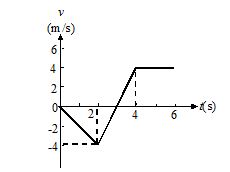
(a)
The time(s) at which the particle is at rest;
(a) 0, 2 s (b) 0, 3 s (c)0, 4 s (d) 0, 1 s
Ans. (b)
(b)
At what time, if any does the particle reverse the direction of its motion;
(a)5s (b)2s (c)3s (d)4s
Ans. (c)
(c)
The average acceleration between 1 and 4s
(a)2 m/s2 (b) 4 m/s2 (c) 6 m/s2 (d)1 m/s2
Ans. (a)
(d)
The instantaneous acceleration at 3s.
(a)3 m/s2 (b)2 m/s2 (c) 6 m/s2 (d)4 m/s2
Ans. (d)
Comprehension (Question Number 27 and 28)
At t = 3s a particle is at x = 7 m and has velocity v = 4 m/s. At t = 7 s, it at x = -5 m and has velocity v = -2 m/s.
27.
Find its average velocity
(a) -2 m/s
(b) -5m/s
(c) -9m/s
(d) -3m/s
Ans. (d)
28.
Its average acceleration.
(a) -1.5 m/s2
(b) -2.9 m/s2
(c) -2.0 m/s2
(d) -3.5 m/s2
Ans. (a)
29.
A body starts moving in a straight line with a constant acceleration a. At a time to after the beginning of motion, the acceleration changes sign remaining the same in magnitude. Find the time t from the beginning of motion in which the point mass returns to the initial position.
(a) t= to (1 + \sqrt{2}) \sqrt{2}
(b) t= to (1 + \sqrt{2}) \sqrt{3}
(c) t= to (1 + \sqrt{3}) \sqrt{2}
(d) t= to (1 + \sqrt{3}) \sqrt{3}
Ans. (a)
30.
A car starts moving rectilinearly, first with acceleration a = 5.0 m/s2 (the initial velocity is equal to zero), then uniformly, and finally, decelerating at the same rate a, comes to a stop. The total time of motion equals t = 25 s. The average velocity during that time is equal to = 72 km per hour. How long does the car move uniformly.
(a) 35 s
(b) 5 s
(c) 5 s
(d) 20 s
Ans. (b)
Practice Questions (JEE Advance Level)
1.
A football is kicked vertically upward from the ground, and a student gazing out of the windows sees it moving upwards past her at 5.00 m/s. The window is 15.0m above the ground, Air resistance may be ignored. How high does the football go above ground? .Take \displaystyle g=10\,\mathbf{m/}{{\mathbf{s}}^{\mathbf{2}}}
(a) 16.25m
(b) 18.5m
(c) 15.6m
(d) 26.86m
Ans. (a)
2.
In the previous question , How much time does it take from the ground to its highest point? Take \displaystyle g=10\,\mathbf{m/}{{\mathbf{s}}^{\mathbf{2}}}
(a) 625sec
(b) 18.5sec
(c) 1.56m
(d) 1.8sec
Ans. d
3.
A train stopping at two stations 4 km apart makes 4 minute on the journey from one of the station to the other. Assuming that it first accelerates with a uniform acceleration x and then that of uniform retardation y, prove then which of the relation between x and y is true?
(a) \frac{1}{{{{x}^{2}}}}+\frac{1}{{{{y}^{2}}}}=2.
(b) \frac{1}{{{{x}^{2}}}}+\frac{1}{y}=2
(c) \frac{1}{{{{x}^{2}}}}+\frac{1}{{{{y}^{2}}}}=2
(d) none
Ans. (a)
4.
Two stop a car, first you require a certain reaction time to begin breaking, then the car slows under the constant braking deceleration. Suppose that the total distance moved by your car during these two phases is 56.7 m when its initial speed is 80.5 km/h and 24.4 m, when its initial speed is 48.3 km/h. What is your reaction time
(a) 1.625sec
(b) 0.74sec
(c) 3.56m
(d) 0.95sec
Ans. (b)
5.
In the previous question ,what is the magnitude of the deceleration?
(a) 4.625 m/sec2
(b) 6.26m/sec2
(c) 6.2m/sec2
(d) 3.95m/sec2
Ans. (c)
6.
A train of length l = 350 m starts moving rectilinearly with constant acceleration a = 3 × 10–2 m/s2. After 30 s the headlight of the train is switched on (event 1). After 60s from this event the tail signal light is switched on (event 2). Find the distance (in m) between these events in the reference frames fixed to the earth.
(a) 240m
(b) 245m
(c) 242m
(d) 242.8m
Ans. (c)
7.
A particle moves in a straight line with an acceleration (12 s2) ms–2 where s is the displacement of the particle in metre from O, a fixed point on the line, at time t seconds. The particle has zero velocity when its displacement from O is –2m. Find the velocity (in m/s) of the particle as it passes through O.
(a) 7m/s
(b) 8m/s
(c) 5m/s
(d) 9m/s
Ans. (b)
8.
Two cars initially at rest start a race. Car A accelerates at constant rate a, while car B moves with zero initial acceleration such that rate of change of acceleration is constant. At t = 1 s both the cars are at same position. Then at t = 0.5 s
(a) carA is ahead
(b) car B is ahead
(c) both are at same positions
(d) data insufficient
Ans. (a)
9.
A passenger reaches the platform and finds that the second last boggy of the train is passing him. The second last boggy takes 3s to pass the passenger, and the last boggy takes 2s to pass him. How late in the milliseconds is the passenger for the departure of the train? Assume that the train accelerates at constant rate and all the boggies are of equal length.
(a) t=3.5sec.=3500ms
(b) t=2.5sec.=2500ms
(c) t=3sec.=3000ms
(d) None
Ans. (a)
10.
A motorboat going downstream overcome a bottle floating in river at a point A. After 60 minutes, it turned back and after some time passed the bottle at a distance 6.0 km from the point A. Find the flow velocity (in km/h) assuming the duty of the engine to be constant.
(a) 3km/hr
(b) 2km/hr
(c) 6km/hr
(d) 3.5km/hr
Ans. (a)
11.
At a distance of 400m from the traffic light brakes are applied to a car moving with velocity of54 km/hr. Determine the distance of the car (in m) relative to the traffic light
1 minute after the application of the brakes if its acceleration is –0.3m/s2.
(a) 9km/hr
(b) 2km/hr
(c) 3km/hr
(d) 6km/hr
Ans. (d)
12.
Two trains A and B leave the same station on parallel tracks.A starts with uniform acceleration of 1/6 m/s2 and attains a speed of 24 km/h. B leaves 40 s later with uniform acceleration of 1/3 m/s2 and attains a speed of 48 km/h. Find the time (in s) after which train B will overtake train A.
(a) 115s
(b) 120s
(c) 100s
(d) 105s
Ans. (c)
13.
A train starts from station A with uniform acceleration for some distance and then goes with uniform retardation for some more distance to come to rest at station B. The distance between stations A and B is 4 km and the train takes 1/15 h to complete this journey. If accelerations are in km per minute unit, then \displaystyle \frac{1}{{{{a}_{1}}}}+\frac{1}{{{{a}_{2}}}}=x. Find the value of x.(a) 3
(b) 4
(c) 2
(d) 1
Ans. (c)
Question Number 14 and 15 are Comprehension Based Questions
Figure shows the v versus t graphs for cars A and B. At t = 0 both are at x = 0.

14.
Estimate where and when they meet again
(a) 20 m; 5 s
(b) 40 m; 5 s
(c) 10 m; 100s
(d) 30 m ; 15 s
Ans. (b)
15.
their velocities when they meet.
(a) vA= 8 m/s; vB= 16 m/s
(b) vA= 4 m/s; vB= 20 m/s
(c) vA= 10 m/s; vB= 50 m/s
(d) vA= 50 m/s; vB= 100 m/s
Ans. (a)
16.
Drops of water fall from the roof of a building 9 m high at regular intervals of time, the first drop reaches the ground at the same instant the fourth drop starts to fall. What are the distances of the second and third drops from the roof?
(a) 4 m and 1 m
(b) 4 m and 2 m
(c) 6 m and 2 m
(d) 6 m and 3 m
Ans : (a)


